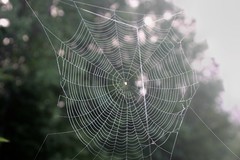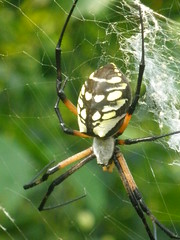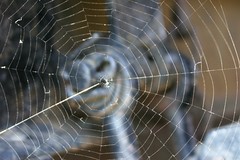According to Sharon B's Directory for Hand Embroidery and Needlework, "A whipped wheel creates a ribbed, circular shape. This stitch can be worked on an even or uneven number of spokes.
"Work a single fly stitch then two straight stitches of the same length each side of the fly stitch tail so that you end up with a circle which has five 'spokes'. These form the foundation stitches."
I tried to do a non-spider's wheel stitch. Thought that a variety of pastel lines of floss that were wrapped with a couple shades of lavender floss might be interesting to try.
What I envisioned and the result were two very different things. The tension was off completely and it greatly affected the appearance (in a negative way). It also was a bit time consuming to wrap all the lines multiple times. I won't be doing that again.
As with past weeks, I included the stitches in my embroidery journal. This week I put my personal reflection, list of things for which I'm grateful, and the name of the stitch along with images of an eagle, cardinal, and ducks (all of which I saw this week).
These items along with the pastel image of the lily pad are from my dad (from cards he received and his stamp collection). I'm still going through and sorting his things. It's a long process, but one that I rather take my time with than rush through.
I did enjoy the whipped wheel or raised spider's web stitch in its traditional form. It has an interesting texture once it is completed.
Since the whipped wheel does - in a way - look like a spider web, I wanted to get a bit more information about spider webs. On Sunstone, it said that "...spider webs are made of silk which the spiders produce through spinnerets. The silk is made of proteins, and is both stronger and more flexible than steel of the same weight."
Spider web I saw on a morning walk
in Grand Marais, Minnesota.
It went on to say that "....though the term 'spider web' generally implies that the web is in use, while 'cobweb' suggests that it’s been abandoned, the two in fact mean the same thing. The term cobweb comes from the Old English word 'coppe,' meaning spider."
Found some interesting facts from The Amazing Spider Web:
What do some spiders do with the webs in order to re-boost their energy levels?
Eat them. As the substance on the web strands looses its stickiness after a short time, and therefore its ability to capture and hold prey, webs have to be constantly re-made by the spider. Because the strands are made of protein, they are therefore recycled by the little creatures.
How do web spinning spiders initially span large gaps that seem impossible to cross (e.g., between two tall trees)?
Many webs are between objects, such as across water, or between large tall spaces, that spiders cannot cross by walking. To overcome this, spiders send a fine thread into a slight breeze which is blowing in the right direction until it catches on the far side.
Then they slowly and carefully walk across this single thread, spinning a second thread as they go - and build on from there.
While at a cotton field in Alabama, I turned by head to
notice this spider at eye level on what had to be
a spider web that was at least 4-feet in diameter.
It is an Argiope aurantia.
Here's more information about this type of spider:
What do spiders use as a measurement in making the patterns of a web?
The length of their bodies. After initially completing the external boundaries, the spider spins five circular threads in the centre, then a spiral of non-sticky threads working from the inside out.
On completing this stage, the spider replaces the initial spirals with more closely spaced sticky ones. The space between each spiral is in proportion to the length between the spider's back legs to its spinners.
Spider web I noticed on the underside of a caboose
in Lindstrom, Minnesota.
Finally it removes the non-sticky strands altogether - and settles down to wait.
In traditional medicine from the days of yore, and even today in some areas, to what use are spider webs put?
Placed on wounds to stop bleeding. Within spider webs there is a substance which can help in the healing process of injuries on human beings. Spider webs are also rich in vitamin K which acts as a clotting agent, thereby helping to stop bleeding.
Spider webs have been used in which artistic pursuit?
Cobweb Painting. Cobweb painting made its appearance in the 1500s in the Austrian Alps.
The webs were layered and wound over fabric and reinforced by brushing with diluted milk. Then watercolors were applied over the top to create the painting, some of which still exist today in private collections.
Even engravings were once made around the shape of cobwebs applied to a suitable surface.










5 comments:
Your journal is a great idea. It was interesting to see your experiment even though it didn't turn out as you expected - it looks like weaving on the photo. And I learnt something new about spiders!
That looks like a tricky stitch!
I am not a spider fan. But I find them fascinating to learn about in a documentary or on a blog post. ;)
I so enjoy coming here and checking out your TAST posts. BEAUTIFUL stitches- I'm just fascinated by them, and how long have I been doing hand work??
I love your journal, that's a fantastic way to keep track of all your stitches!
fascinating stitch and looks as though it is pretty tricky to execute, mind you you make it look pretty easy...xx
Post a Comment